Abstract
In the precast building structure, the joint is the key part that affects the mechanical performance of the assembly structure. By selecting coarse and fine fraction aggregate; adding high quality mineral admixture, expansive agent, and water-reducing agent; and optimizing the mixture ratio design, precast members joint concrete (PMJC) with self-compacting performance, micro-shrinkage, good volume stability, and strength matching with precast concrete is developed. In this study, the PMJC with a water-binder ratio, fly ash, ultra-fine silicon powder, sand rate, expansive agent, and water-reducing agent of 0.38, 30%, 3%, 47.7%, 8%, and 0.7%, respectively, showed a good workability which could meet the conditions of on-site construction. In addition, the strength matched the precast members, and the PMJC had certain ductility and stability, small early contraction, and met the requirements of the joint material.
1. Introduction
With the rapid growth of the economy and continuous improvement of urbanization, the current development environment of the construction industry in China has undergone profound changes. The buildings in China are mainly cast-in-place, the form is single, and there are not many building products to choose. The construction speed, quality, and usage function of the products are seriously affected [,,].
Prefabricated building is a building product completed by prefabricating part or all of the components of the building in the factory [,]. Then, the components are transported to the construction site and assembled through reliable connection. Lu et al. noted that compared with traditional buildings, prefabrication reduces waste by 15.38% []. In the assembly integral structure, the joint is the key part that affects the mechanical performance of the structure. The connection between the assembly component nodes can be divided into the dry connection and wet connection []. Although the wet connection is the most important connection mode of the assembly structure at present [], there are many shortcomings in this connection mode. To a large extent, the wet connection depends on the work and mechanical properties of the precast member joint concrete []. The research and development of joint concrete, which has vibration-free tamping, good flowability [,], good crack resistance after hardening, and good adaptability to strength and deformation performance with precast concrete members, will be of great significance to ensure the quality of assembled construction engineering [,,].
Researchers have found that the addition of mineral admixtures in ordinary concrete can change the rheological properties, strength, hydration heat, and shrinkage of concrete, which has promising applications. However, the effect of a single admixture is often limited, and different mineral admixtures often have different effects.
Numerous studies have shown that the use of mineral admixtures such as fly ash and blast furnace slag can increase the flow of concrete without increasing the cost []. The addition of these mineral admixtures can reduce the amount of high-efficiency water-reducing agents to maintain a similar slump flow to concrete made with cement only. Fly ash improves the rheological properties of concrete, reduces the possibility of cracking [,], reduces the hydration heat, and improves the durability of concrete [,,]. Kim [] and Miura [] found that replacing cement with 30% fly ash significantly improved the rheological properties, and excellent compatibility and flowability could be obtained. Pandey [] studied the relationship between fly ash admixture and compressive strength, and found that as the fly ash increased, the porosity and average pore size increased, and the compressive strength decreased. Silica fume has higher reactivity than fly ash due to its finer particle size than fly ash but requires more water for its higher specific surface area, resulting in a lower flowability. To further improve the performance of concrete, researchers have found that the synergistic effect between fly ash and silica fume results in a ternary mixture (cement, fly ash, silica fume), which exhibits excellent properties [,,,]. Kwan [] found that ternary mixtures had higher packing densities than binary mixtures, with the highest packing density reaching 0.752. With the increase of packing density, the minimum voids ratio and matrix water requirement decreased. Radlinski [] found a synergistic effect (higher compressive strength, resistance to chloride ion penetration, lower initial water absorption) after 7 days for the ternary mixture with 20% fly ash and 5% silica fume, and noted that this synergistic effect was due to chemical (increased hydration products) and physical (smaller initial particle spacing) effects.
Due to the large amount of cementitious materials, PMJC will produce relatively large shrinkage. Reducing the shrinkage of concrete is also an important topic of concrete engineering. The addition of mineral admixtures such as fly ash and slag can reduce the shrinkage of concrete. Some researchers have found that the shrinkage of concrete decreased with the increase of the amount of mineral admixture [,], while others have found contradicting results []. For example, Li et al. [] found that the drying shrinkage rate of high-performance concrete increased with the increase of fly ash content in the first 28 days and pointed out that the optimal content of fly ash was 20%. Yoo et al. [] studied the shrinkage of cement/fly ash/silica fume ternary mixed system and found that with the increase of fly ash, the shrinkage value decreased. In addition, with the increase of silica fume, the shrinkage value increased. They also proposed that the addition of expansive agent can effectively reduce the shrinkage of concrete, and 10% expansion agent can reduce the autogenous shrinkage of 68%.
At present, there is less information about the practical application of ternary hybrid system in the joint concrete of precast members, and the safe and economic treatment of joints in precast members is a very practical topic. To promote the application of ternary hybrid system in joint concrete, it is necessary to study the mechanical properties of ternary hybrid concrete. In this experiment, the working performance, and the mechanical and shrinkage properties of ternary hybrid concrete with different mix ratios were studied, and an optimal mix ratio was proposed.
2. Experimental Program
2.1. The Mix Proportion Technology of Joint Concrete
In this experiment, water-reducing agent, expansive agent, fly ash and ultra-fine silica powder were mixed together. By adding polycarboxylic acid superplasticizer, the amount of water can be reduced, and the strength of concrete can be improved. Moreover, polycarboxylic acid superplasticizer can wrap the surface of cement particles and reduce the friction resistance between cement particles, thus improving the flowability of concrete mixtures. The joint concrete of prefabricated members adopts lower water-binder ratio and more cementitious material dosage, so it will lead to a shrinkage in the concrete, which will induce cracks in concrete structure. By changing the proportion of coarse and fine aggregate, adopting the technology of admixture, the friction between the particles of concrete mixture and the early shrinkage of concrete can be reduced, and the fluidity of concrete mixture can be improved.
In the case of realizing the self-weight and vibration-free concrete forming, the amount of cementitious materials should be reduced. At the same time, attention should be paid to the optimization of raw materials and aggregate grading, as well as the reduction of the amount of cementitious materials, while optimizing the mix design.
The principle to determine the sand rate is to ensure the concrete mixture has good cohesion and flowability. When a reasonable sand ratio is used, the concrete mixture can obtain greater flowability and maintain good cohesion and water retention when the amount of water and cement is fixed.
In the mix proportion design of the joint concrete of prefabricated members, the proportion of coarse aggregate should be strictly controlled, the gradation of coarse aggregate and the mobility and filling property of concrete mixture should be improved, and the problems of segregation and bleeding of concrete should be solved. The maximum particle size of coarse aggregate should not exceed 20 mm.
To restrain the early shrinkage of the concrete mixture, the self-compactness of concrete was improved to prevent the shrinkage crack after the hardening of concrete. The crack resistance of the concrete mixture was increased, and the cohesion of concrete and the appearance quality of concrete mixture were improved by adding an expansive agent. Using high-quality mineral admixtures such as fly ash and ultra-fine silicon powder, the yield stress of concrete mixture can reach the allowable range. At the same time, the workability of concrete can be enhanced, the homogeneity and the resistance ability of cthe oncrete mixture can be improved, and the friction between coarse and fine aggregates can be reduced.
According to the design method of concrete mix proportion in Chapter 5 of “Technical Specification for the Application of self-compacting concrete” (JGJ/T283/2012), the mix proportion design of the joint concrete of prefabricated members was carried out to determine the volume fraction of sand, water-binder ratio, and proportion of mineral admixture in the concrete mixture.
2.2. Materials
The raw material of concrete in this experiment is P.O 42.5 ordinary Portland cement. Well-graded natural gravel was used as the coarse aggregate with the size of 5–20 mm. River sand with good gradation was used as the fine aggregate. As shown in Table 1. the fineness modulus of river sand was 2.69. The grade I fly ash was produced by Henan Sitong Chemical Construction, and the physical indexes are shown in Table 2. UEA concrete expansive agent was used. Ultra-fine silicon fume is a type of quasi-spherical solid ultra-fine powder which comprises natural quartz stone. The solid content and water reduction rate of polycarboxylic acid superplasticizer were 20% and 25%, respectively.

Table 1.
Screening results of sand.

Table 2.
Physical indexes of fly ash.
2.3. Test Method of Working Performance
The fluidity of concrete refers to the ability of the mixture to fill the gap between the formwork. The slump flow test can be used to evaluate the unrestricted deformation ability of self-compacting concrete mixture. In this paper, the slump flow test was performed according to the Chinese industry standard “Technical specification for application of self-compacting concrete” (JGJ/T-283-2012).
The passing ability test was performed according to the J-Ring flow method in the abovementioned standard (JGJ/T-283-2012). The J-Ring flow degree is the average value of the two diameters of the extended surface perpendicular to each other after the slump flow of the concrete mixture. The difference (PA) between slump-flow and J-Ring flow represents the passing ability of PMJC. The larger PA, the wider the application range of PMJC, which means that it can be applied to smaller reinforcement spacing.
2.4. Test Methods of Mechanical Properties
The mechanical properties tests were performed according to the methods stipulated in the national standard “Standard for test methods of concrete physical and mechanical properties” (GB50081-2019). The cube compressive strength and splitting tensile strength of 8 groups of test blocks were measured at 3 ages (3 days, 7 days, 28 days). The standard cube specimens with the size of 150 × 150 × 150 mm were placed into the standard nursing room with a temperature of 20 ± 3 °C and relative humidity of more than 90%.
The elastic modulus of concrete is a very important performance parameter of engineering materials. According to GB50081-2019, the specimen size was 100 × 100 × 300 mm. There were 6 pieces in each group, of which 3 were used to determine the axial compressive strength, and the other 3 were tested for elastic modulus. After pouring and forming, the axial compressive strength and elastic modulus of concrete were measured at the age of 7, 14, and 28 days.
The autogenous shrinkage of concrete was measured according to the non-contact method in the national standard “Standard for test methods of long-term performance and durability of ordinary concrete” (GB/T50082-2009).
3. Results
3.1. Working Performance
Eight groups of tests were designed considering the water-binder ratio, the type and content of mineral admixtures, and different sand rates. The slump-flow, T500 time, and J-Ring tests were performed, respectively, and the effects of the above factors on the working performance of PMJC were analyzed. The mix proportion design is shown in Table 3, and the weight of raw materials per cubic meter of concrete is shown in Table 4. The test data of working performance are shown in Table 5 and Table 6, respectively.

Table 3.
Mix proportion of PMJC.

Table 4.
The weight of raw materials per cubic meter of PMJC (unit: kg/m3).

Table 5.
Slump-flow and T500.

Table 6.
J-Ring test.
By comparing groups 1, 2, and 8, the effect of the water-binder ratio on the working performance of joint concrete of prefabricated members was studied, and the water-binder ratio had a great influence on the working performance of the mixture. With the increase of the water-binder ratio, the flowability of concrete mixture increased. The maximum slump-flow was 705 mm when the water binder ratio was 0.43, and the minimum slump was 650 mm when the water binder ratio was 0.32. It was noteworthy that when the water-binder ratio increased, the concrete mixture was prone to segregation and bleeding, and the passing ability decreased accordingly.
By comparing groups 2, 3, 4, 5, and 6 of tests, the influence of mineral admixtures on the performance of concrete was studied. With the increase of fly ash content, the slump-flow of joint concrete increased. The results show that fly ash can change the workability of joint concrete under a certain amount. The experimental results show that the matrix exhibited the best fluidity when 30% fly ash was added. The main reason was that the density of fly ash was smaller than that of cement, and the spherical granular structure could reduce the friction resistance among particles to a certain extent, thus increasing the flow performance of the mixture. The slump loss of PMJC increased with the increase of time, and the total loss increased with the increase of fly ash replacement. The T500 and PA value decreased with the increase of fly ash content, and the PA value was the largest when the fly ash content was 0. The PA values of group 4 and group 5 were smaller with 15 mm and 20 mm respectively, which meant that these two groups of PMJC were suitable for smaller reinforcement spacing at the joints. At this time, the fly ash replacement ratio reached 30%, and the silica fume replacement ratio was 3% and 4%, respectively. The degree of cement was smaller than that of cement, so when fly ash replaced cement equally, the volume of cementitious material increased, the cement particles in the mixture were dispersed, and the water consumption was reduced. Moreover, due to the morphological effect and filling effect of fly ash, the concrete mixture was more compact, and the connecting passage could not be formed, thus avoiding bleeding and segregation. It can be considered that the addition of fly ash can improve the cohesion and passing ability of the mixture. Ultra-fine silicon powder can improve the flow rate of mixtures to a certain extent, but when it exceeds a certain amount, it will affect the flow speed of mixtures, mainly because the specific surface area of micro-silicon powder is relatively large. According to the results of this test, the best overall working performance of the concrete matrix was achieved when the silica fume replacement ratio reached 3%. When the content exceeded a certain requirement, the water requirement increased, resulting in a decrease in the flow rate. The results show that the mixing of fly ash and ultra-fine silica powder can significantly improve the flow speed and filling capacity of concrete mixtures.
Comparing with groups 2 and 7 of tests, it can be found that the increase of sand ratio led to the increase of slump-flow loss, and the decrease of flow velocity and filling capacity in the later stage of slump flow. The main reason was that mortar reduced the friction between aggregate particles to a certain extent. Increasing the sand ratio in a certain range can improve the performance of the mixture, but when the sand ratio exceeds a certain range, the specific surface area of sand becomes larger than that of coarse aggregate. When the sand ratio increases, the total surface area of coarse aggregate will increase, but when the slurry content is certain, the total surface area of coarse aggregate will increase. The slurry encapsulated with coarse aggregate will become smaller, which will lead to increased friction between coarse aggregate and fine aggregate, smaller fluidity, and lower flow rate.
3.2. Mechanical Properties
Considering the effect of the water-binder ratio, mineral admixtures, and sand ratio, eight groups of specimens were designed. The cubic compressive strength, elasticity modulus under static compressive stress, and splitting tensile strength of the eight groups of specimens were tested, and the effects of the above factors on the strength and deformation properties of concrete at different ages were analyzed. The mix design was the same as Table 3. The test results are shown in Table 7, Table 8 and Table 9, respectively.

Table 7.
Results of the cube compressive strength test.

Table 8.
Results of the cube splitting tensile strength test.

Table 9.
Calculated values of the elasticity modulus.
By comparing groups 1, 2, and 8 of tests shown in Table 7, the influence of water-binder ratio on the mechanical properties of concrete was studied. When the water-binder ratio was 0.43 (PMJC1) and 0.38 (PMJC2), the growth rate of compressive strength of concrete in the later stage was faster than that in the early stage, but the growth rate in the later stage was slower than that in the early stage when the water-binder ratio was 0.32 (PMJC8). With the decreased water-binder ratio, the compressive strength of concrete increased. The main reason was that when the water-binder ratio was low, the mixture formed a relatively compact structure, which reduced the porosity. When the water-binder ratio was 0.43 and 0.38, the growth rate of splitting tensile strength of concrete in the later stage was faster than that in the early stage, but the growth rate of concrete with the water-binder ratio of 0.32 in the later stage was slower than that in the early stage. With the decreased water-binder ratio, the splitting tensile strength of concrete increased. The reason was the same as the compressive strength mentioned above. The elasticity modulus of concrete at 7 d, 14 d, and 28 d with the water-binder ratio of 0.32 (PMJC8) increased 46%, 37.4%, and 12% respectively, compared with the water-binder ratio of 0.38 (PMJC2), as shown in Table 9. The results show that the elasticity modulus of concrete increased with the decreased water-binder ratio. When the water-binder ratio was 0.43 and 0.38, the elasticity modulus of concrete increased faster in the early stage than in the later stage, while the latter increased faster in the later stage than in the early stage when the ratio of water to binder was 0.32.
Groups 2, 3, 4, 5, and 6 of experiments were compared to study the effects of mineral admixtures on the mechanical properties of concrete. The test results are shown in Figure 1. The compressive strength of concrete specimens with a reference mix ratio of 28 days was 49.63 MPa, which was higher than that of concrete with mineral admixtures. Figure 1a,b shows that fly ash had an effect on the strength development of concrete in the early stage. Under the same conditions, the compressive strength of the mixture decreased with the increase of fly ash content. When the content of fly ash was constant, there was more content of ultra-fine silica fume, and the strength concrete was higher. Figure 1c,d shows that concrete with 30% fly ash and 4% ultra-fine silica fume showed higher strength than concrete with 30% fly ash alone, while concrete with 30% fly ash and 3% ultra-fine silica fume showed lower strength than concrete with 30% fly ash alone. The results prove that the compressive strength of concrete can be improved by adding ultra-fine silica fume in a certain amount. The splitting tensile strength of concrete with 30% fly ash was 0.15 MPa lower than that of concrete with 20% fly ash. The main reason was that with the increase of fly ash content, most of the cement was replaced, resulting in the reduction of hydration products, and finally the reduced strength of concrete. At the age of 28 d, the splitting tensile strength of the base mix ratio reached the maximum of 3.15 MPa, and the concrete with 30% fly ash reached the minimum of 2.52 MPa, which indicated that the splitting tensile strength had a tendency to increase in the later strength for the concrete with mineral admixtures.
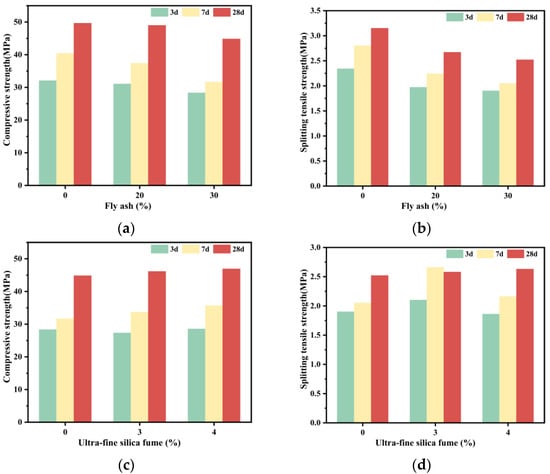
Figure 1.
Influence of mineral admixtures on the mechanical properties of PMJC. (a) Influence of fly ash on compressive strength. (b) Influence of fly ash on splitting tensile strength. (c) Influence of ultra-fine silica fume on compressive strength. (d) Influence of ultra-fine silica fume on splitting tensile strength.
3.3. Autogenous Shrinkage Performance
In this experiment, the expansive agent was used to restrain the shrinkage of concrete. NELD-ES731 (12-way) non-contact concrete shrinkage and expansion deformation tester was used to measure the early autogenous shrinkage rate of concrete. The test instrument is shown in Figure 2.
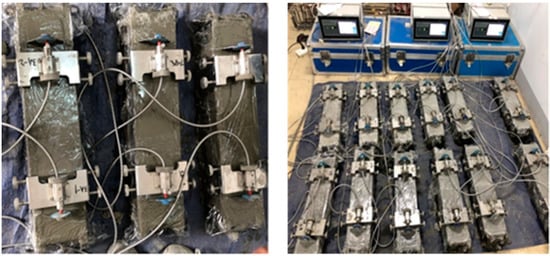
Figure 2.
Concrete autogenous shrinkage test.
Concrete autogenous shrinkage rate should be calculated according to the following formula:
where εst is the shrinkage rate of concrete with test period T(h), t is calculated from the initial reading, L1O is the initial reading of left non-contact displacement sensor (mm), L1t is the reading of the left non-contact displacement sensor during the test period of t(h), L2O is the initial reading of right non-contact displacement sensor(mm), L2t is the left non-contact displacement sensor reading (mm) for t(h), and LO is the measured distance (mm) of the specimen, which is equal to the length of the specimen minus the sum of the lengths of the two reflecting targets embedded in the specimen along the length direction of the specimen.
In this test, prism specimens of 100 × 100 × 515 mm size were used []. Three specimens were produced for each group, and ten groups of specimens were produced in this test, with 30 specimens in total. The effect of the water-binder ratio, mineral admixture content, and expansion agent content were studied, respectively. The mix proportion of the non-contact autogenous shrinkage test is shown in Table 10, the amount of materials used per cubic meter is shown in Table 11, and the test data are shown in Figure 3.

Table 10.
Mix proportion of the non-contact autogenous shrinkage test.

Table 11.
The weight of raw materials per cubic meter of PMJC (unit: kg/m3).
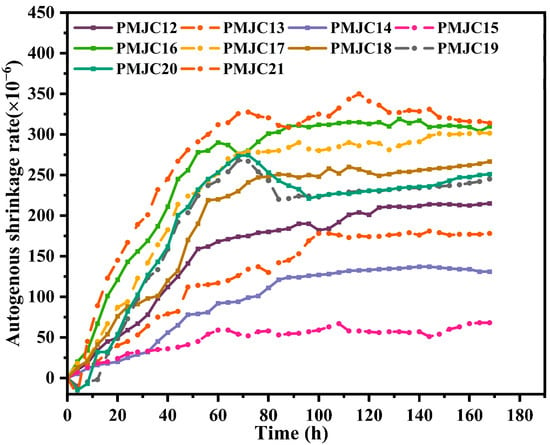
Figure 3.
Tests results of the autogenous shrinkage of PMJC.
By comparing groups 13 and 16, groups 14 and 17, groups 15 and 18, and groups 19 and 21, respectively, the experimental data increased linearly and rapidly before 48 h but slowly after 48 h. Compared with different water-binder ratios under the same conditions shown in Figure 4, the larger the water-binder ratio, the smaller the shrinkage. At 168 h, the autogenous shrinkage of concrete with 20% fly ash and 0.43 water-binder ratio was 178 × 10−6 much smaller than that of concrete with a 0.38 water-binder ratio, as shown in Figure 4a. When the content of fly ash was 30%, as shown in Figure 4b, the shrinkage of concrete with the water-binder ratio of 0.43 was 131 × 10−6 less than that of concrete with the water-binder ratio of 0.38, which was 301.5 × 10−6. Figure 4d shows that the shrinkage of concrete with fly ash content of 30%, ultra-fine silica powder content of 3%, and water-binder ratio of 0.43 was 68 × 10−6 smaller than that of concrete with water-binder ratio of 0.38, which was 266.6 × 10−6. Figure 4c shows that when the content of fly ash was 30%, the shrinkage of concrete with the water-binder ratio of 0.38 was 245 × 10−6 smaller than that of concrete with the water-binder ratio of 0.32, which was 314 × 10−6. When the water-binder ratio was small, the internal water content of concrete could not meet the requirements of cement hydration, which led to the self-drying shrinkage of internal cementitious materials. When cement hydration occurred, the generated hydration products gradually filled up the space. The smaller the water-binder ratio was, the less the amount of water was used, and the less the remaining voids were filled by hydration products. Thus, the structure became more compact. The shrinkage mechanism of concrete was that when the moisture content in the voids decreased, a large number of voids were generated in the cement paste. With the evaporation of the internal moisture decreased, the tensile stress produced by the capillary holes and the shrinkage of concrete were larger.
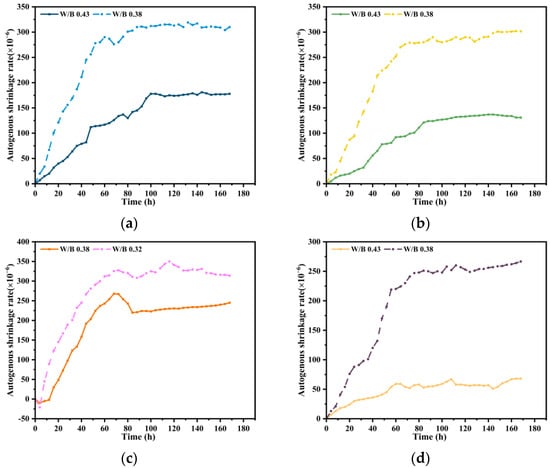
Figure 4.
Influence of water-binder ratio on autogenous shrinkage of PMJC. FA: the replacement percentage of fly ash; SF: the replacement percentage of ultra-fine silicon fume; EA: the content of expansive agent. (a) PMJC13 and PMJC16 (FA: 20%, SF: 0, EA: 0). (b) PMJC14 and PMJC17 (FA: 30%, SF: 0, EA: 0). (c) PMJC19 and PMJC21 (FA: 30%, SF: 0, EA: 0.8%). (d) PMJC15 and PMJC18 (FA: 30%, SF: 3%).
As shown in Figure 5, when the water-binder ratio was 0.43, the content of expansive agent was 0. The autogenous shrinkage test of concrete without mineral admixture reached the maximum value of 215 × 10−6 at 168 h, and the shrinkage of concrete with 30% fly ash and 3% ultra-fine silica powder reached the minimum value of 68 × 10−6, which indicates that mineral admixture can restrain the autogenous shrinkage of concrete to a certain extent. Comparing groups 12, 13, and 14 of test data in Figure 5a, it can be seen that when more fly ash was added, the restraint of autogenous shrinkage of concrete became more obvious when the water-binder ratio, amount of expansive agent, and age were the same. Figure 5b shows that when the water-binder ratio was 0.38 and the content of expansive agent was 0, the autogenous shrinkage of concrete decreased with the increase of the fly ash content. Compared with groups 14 and 15 of test data in Figure 5c, the shrinkage rate of concrete with 30% fly ash alone was larger than that of concrete with 30% fly ash and 3% ultra-fine silica powder at the same age, water-binder ratio, and expansion agent content. At the same time, before the age of 48 h, the autogenous shrinkage rate of concrete increased rapidly, and later the autogenous shrinkage rate increased slowly, which indicated that the autogenous shrinkage of PMJC mainly occurred in the early stage, and corresponding measures could be taken to restrain the autogenous shrinkage in the early stage. Figured 5d indicates that the addition of 0.8% expansive agent can generate a similar shrinkage value to that of the ternary system, implying that the addition of micro expansive agent can improve the shrinkage performance of PMJC. In summary, fly ash and ultra-fine silica fume can reduce the autogenous shrinkage of concrete and the early cracking of concrete, and improve the overall stability of concrete.
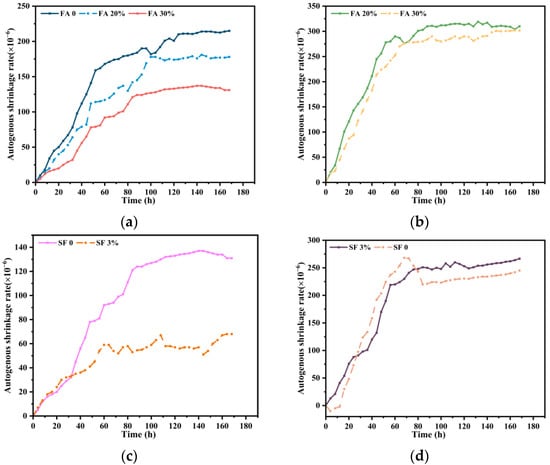
Figure 5.
Influence of mineral admixtures on the autogenous shrinkage of PMJC. (a) PMJC12, PMJC13, and PMJC14 (W/B: 0.43, SF: 0, EA: 0). (b) PMJC16 and PMJC17 (W/B: 0.38, SF: 0, EA: 0). (c) PMJC14 and PMJC15 (W/B: 0.43, FA: 30%, EA: 0). (d) PMJC18 (EA: 0) and PMJC19(EA: 0.8%) (W/B: 0.38, FA: 30%).
Figure 6 showed that the shrinkage rate of concrete with 0.8% and 1% expansive agent was smaller than that without expansive agent before 30 h. At 168 h, the shrinkage of concrete with 0.8% expansive agent was 245 × 10−6, slightly smaller than that with 1% expansive agent 251 × 10−6. The results show that a certain amount of expansive agent can restrain the autogenous shrinkage of concrete. The expansive agent produced expansive hydration material through hydration reaction and filled in the pore, so micro-expansion occurred in the early stage. Before the age of 48 h, the shrinkage rate of all the tests increased rapidly, and the later shrinkage rate increased slowly, which indicated that the addition of expansive agent had no effect on the time variation of concrete shrinkage. The autogenous shrinkage of concrete was mainly due to the decreased humidity inside the concrete, which resulted in the larger tensile stress of the capillary pore and shrinkage. The addition of expansive agent can fill the capillary pore, and the expansive agent can react with the hydration product to make the concrete expand in volume and restrain the shrinkage of concrete.
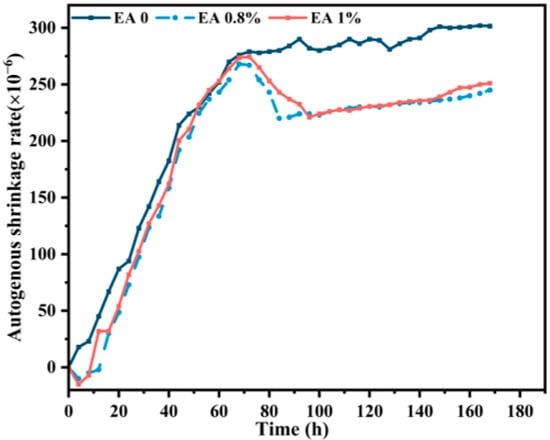
Figure 6.
Influence of expansive agent content on the autogenous shrinkage of PMJC (PMJC17, PMJC19, and PMJC20).
4. Discussion on Optimal Mix of the Concrete
From the viewpoint of workability, the ternary system (cement, fly ash, and silica fume) exhibited the greatest slump-flow and passing ability compared to the binary system (cement and fly ash). For example, the slump-flow of PMJC4 and PMJC5 was 715 mm and 690 mm, and the PA value was 15 mm and 20 mm, respectively. Under the same water-binder ratio, the early compressive strength and splitting tensile strength of the ternary system were lower than the reference group. However, the later development was faster, and the 28-day strength was close to that of the reference group.
Figure 7 compares the PMJC autogenous shrinkage values under different cementitious materials. It can be found that the autogenous shrinkage value of the ternary system was the smallest under the same water-binder ratio. When the water-binder ratio was 0.43, the 168 h autogenous shrinkage of the ternary system was 68 × 10−6, and the unitary and binary systems were 215 × 10−6 and 131 × 10−6, respectively. When the water-cement ratio was 0.38, the 168 h autogenous shrinkage was 266.6 × 10−6 for the ternary system and 301.5 × 10−6 for the binary system, which was only 12% lower, indicating that the early autogenous shrinkage value of the ternary system increased more rapidly as the water-binder ratio decreased. As can be seen from Figure 5d, the 168 h autogenous shrinkage value of the ternary system (266.6 × 10−6) was close to the shrinkage value of the binary system with expansion agent (245 × 10−6). According to the above conclusions, when the expansion agent content was 0.8% and 1%, PMJC autogenous shrinkage values did not differ much, and the relative error between the two was only about 2%. Therefore, adding 0.8% expansion agent in the ternary system can be considered to further reduce the autogenous shrinkage of PMJC. In summary, when the fly ash content is 30%, silica fume is 3%, and expansion agent is 0.8%, PMJC will exhibit excellent workability, mechanical properties, and low autogenous shrinkage.
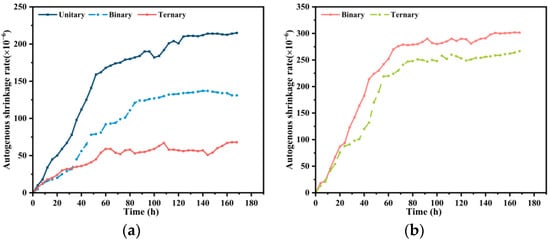
Figure 7.
Effect of the mineral blending system on the autogenous shrinkage of PMJC. (a) PMJC12, PMJC14, and PMJC15. (b) PMJC17 and PMJC18.
5. Conclusions
In this paper, the working performance, mechanical properties, and autogenous shrinkage performance of PMJC were tested and studied. The research results provided data references and technical support for special lifting formwork, as well as rapid distribution technology and equipment of the concrete for the joint construction of industrial building components. The main conclusions of this paper are as follows.
By adding mineral admixtures and superplasticizer, reasonably selecting the gradation of the coarse and fine aggregate and sand ratio, and optimizing the concrete mixture design, a special PMJC with good working performance and suitable for the concrete strength of precast members was prepared. The yield stress of the concrete mixtures was reduced to an appropriate range with sufficient plastic viscosity. The mixtures can flow freely under the action of self-weight to fill the voids in the formwork and form a uniform and dense structure.
With the increase of the water-binder ratio, the fluidity and plastic viscosity of concrete continued to improve. When the water-binder ratio was 0.38, the performance of concrete was generally good. Mineral admixtures can significantly improve the performance of concrete. Under the same conditions, the passing ability of mixtures with 47.7% sand ratio was better than that of mixtures with 51.7% sand ratio.
The larger the water-binder ratio, the better the fluidity of concrete, and the smaller the compressive strength, splitting tensile strength, and elastic modulus. When the water-cement ratio was 0.38, the fly ash content was 30%, the ultra-fine silica powder content was 3%, and the compressive and splitting tensile strength of concrete were 46.14 MPa and 2.58 MPa, respectively, which meet the basic strength requirements.
The autogenous shrinkage of concrete increased rapidly before the age of 48 h, and tended to be flat after the age of 48 h. The smaller the water-binder ratio, the larger the autogenous shrinkage of concrete. The autogenous shrinkage of concrete can be significantly reduced by adding an expansive agent. At the age of 168 h, the shrinkage of concrete with 0.8% expansive agent was 6 × 10−6 smaller than that with 1% expansive agent. When the content of expansive agent was 0.8%, the effect was optimal. With the increase of fly ash content, the autogenous shrinkage of concrete decreased. When the fly ash content was the same, the autogenous shrinkage of concrete could be further reduced by adding ultra-fine silica fume.
Author Contributions
Data curation, H.Z.; formal analysis, Y.H. and D.J.; investigation, D.J. and C.L.; methodology, H.Z., Y.H. and D.J.; project administration, H.Z.; resources, J.T.; supervision, H.Z.; writing—original draft, D.J. and H.Z.; writing—review and editing, H.Z. and Y.H. All authors have read and agreed to the published version of the manuscript.
Funding
This research was funded by the Sub Project of National Key Research and Development Program of China, grant number 2017YFC0703904-3, the CSCEC Technology Research and Development Project, grant number CSCEC-2021-Z-24 and the National Natural Science Foundation of China, grant number 51779231.
Institutional Review Board Statement
Not applicable.
Informed Consent Statement
Not applicable.
Conflicts of Interest
The authors declare no conflict of interest.
References
- Xue, X.; Wu, H.; Zhang, X. Measuring energy consumption efficiency of the construction industry: The case of China. J. Clean. Prod. 2015, 107, 509–515. [Google Scholar] [CrossRef]
- Zhang, P.; London, K. Sustainable Development of Construction Industry—The China Case. Adv. Mater. Res. 2017, 622–623, 1701–1705. [Google Scholar] [CrossRef]
- West, G.H.; Lippy, B.E.; Cooper, M.R. Toward responsible development and effective risk management of nano-enabled products in the U.S. construction industry. J. Nanopart. Res. 2016, 18, 49. [Google Scholar] [CrossRef]
- Zhao, W.; Tong, J.; Yuan, S. Research on the Connection Method of Column-Wall Member in Precast Frame-Shear Wall Structure. J. Shenyang Jianzhu Univ. Nat. Sci. 2015, 31, 408–417. [Google Scholar]
- Han, S.-J.; Lee, D.H.; Cho, S. Estimation of transfer lengths in precast pretensioned concrete members based on a modified thick-walled cylinder model. Struct. Concr. 2016, 17, 52–62. [Google Scholar] [CrossRef]
- Lu, W.; Lee, W.M.W.; Xue, F. Revisiting the effects of prefabrication on construction waste minimization: A quantitative study using bigger data. Resour. Conserv. Recycl. 2021, 170, 105579. [Google Scholar] [CrossRef]
- Aninthaneni, P.K.; Dhakal, R.P.; Marshall, J. Nonlinear Cyclic Behaviour of Precast Concrete Frame Sub-Assemblies with “Dry” End Plate Connection. Structures 2018, 14, 124–136. [Google Scholar] [CrossRef]
- Roshchina, S.; Ezzi, H.; Shishov, I. Evaluation of the deflected mode of the monolithic span pieces and preassembled slabs combined action. IOP Conf. Ser. Earth Environ. Sci. 2017, 90, 012075. [Google Scholar] [CrossRef]
- Zhaoping, L.I.; Wang, C.; Huifeng, S.U. Mechanical Property of Tenon-Groove Joints for Metro Station Constructed by Prefabricated Structure. China Railw. Sci. 2015, 36, 7–11. [Google Scholar]
- Shi, C.; Wu, Z.; Lv, K.X. A review on mixture design methods for self-compacting concrete. Constr. Build. Mater. 2015, 84, 387–398. [Google Scholar] [CrossRef]
- Vejmelková, E.; Kot’átková, J.; Čáchová, M.; Koňáková, D. Comparison of the Effects of Different Pozzolana on the Properties of Self-Compacting Concrete. Key Eng. Mater. 2016, 677, 103–107. [Google Scholar] [CrossRef]
- Lago, B.D.; Negro, P.; Lago, A.D. Seismic design and performance of dry-assembled precast structures with adaptable joints. Soil Dyn. Earthq. Eng. 2018, 106, 182–195. [Google Scholar] [CrossRef]
- Quan-Biao, X.U.; Chen, G.; Jing-Feng, H.E. Flexural performance experiment of connection joint for composite reinforcement concrete prefabricated square piles. J. Zhejiang Univ. 2017, 51, 1300–1308. [Google Scholar]
- Conroy, K.; Hoigard, K.R. Evaluation and Repair of Insufficiently-Reinforced Precast Concrete Double Tee Members. In Proceedings of the Seventh Congress on Forensic Engineering, Miami, FL, USA, 15–18 November 2015. [Google Scholar]
- Sonebi, M. Medium strength self-compacting concrete containing fly ash: Modelling using factorial experimental plans. Cem. Concr. Res. 2004, 34, 1199–1208. [Google Scholar] [CrossRef]
- Sonebi, M.; Bartos, P.J.M. Filling ability and plastic settlement of self-compacting concrete. Mater. Struct. 2002, 35, 462–469. [Google Scholar] [CrossRef]
- Yahia, A.; Tanimura, M.; Shimabukuro, A.; Shimovama, Y. Effect of rheological parameters on self-compactability of concrete containing various mineral admixtures. In Proceedings of the International RILEM Symposium on Self-Compacting Concrete, Stockholm, Sweden, 13 September 1999. [Google Scholar]
- Khayat, K.H.; Khayat, J.; Lessard, M. Performance of self-consolidating concrete for casting basement and foundation walls. ACI Mater. 2000, 97, 374–380. [Google Scholar]
- Siddique, R.; Aggarwal, P.; Aggarwal, Y. Mechanical and durability properties of self-compacting concrete containing fly ash and bottom ash. J. Sustain. Cem.-Based Mater. 2012, 1, 67–82. [Google Scholar] [CrossRef]
- Kinomura, K.; Ishida, T. Enhanced hydration model of fly ash in blended cement and application of extensive modeling for continuous hydration to pozzolanic micro-pore structures. Cem. Concr. Compos. 2020, 114, 103733. [Google Scholar] [CrossRef]
- Kim, J.K.; Han, S.H.; Park, Y.D. Experimental research on the material properties of super flowing concrete. In Production Methods and Workability of Concrete; CRC Press: London, UK, 1996. [Google Scholar]
- Miura, N.; Takeda, N.; Chikamatsu, R. Application of Super Workable Concrete to Reinforced Concrete Structures with Difficult Construction Conditions. Am. Concr. Inst. ACI Spec. Publ. 1993, 140, 163–186. [Google Scholar]
- Pandey, S.; Sharma, R. The influence of mineral additives on the strength and porosity of OPC mortar. Cem. Concr. Res. 2000, 30, 19–23. [Google Scholar] [CrossRef]
- Thomas, M.D.A.; Shehata, M.H.; Shashiprakas, S.G.; Hopkins, D.S.; Cail, K. Use of ternary cementitious systems containing silica fume and fly ash in concrete. Cem. Concr. Res. 1999, 29, 1207–1214. [Google Scholar] [CrossRef]
- Shehata, M.H.; Thomas, M. Use of ternary blends containing silica fume and fly ash to suppress expansion due to alkali–silica reaction in concrete. Cem. Concr. Res. 2002, 32, 341–349. [Google Scholar] [CrossRef]
- Mehta, P.K.; Gjorv, O.E. Properties of portland cement concrete containing fly ash and condensed silica fume. Cem. Concr. Res. 1982, 12, 587–595. [Google Scholar] [CrossRef]
- Thomas, M.D.A.; Bamforth, P.B. Modeling chloride diffusion in concrete effect of fly ash and slag. Cem. Concr. Res. 1999, 29, 487–495. [Google Scholar] [CrossRef]
- Kwan, A.K.H.; Wong, H.H.C. Packing density of cementitious materials: Part 2—Packing and flow of OPC + PFA + CSF. Mater. Struct. 2008, 41, 773–784. [Google Scholar] [CrossRef]
- Radlinski, M.; Olek, J. Investigation into the synergistic effects in ternary cementitious systems containing portland cement, fly ash and silica fume. Cem. Concr. Compos. 2004, 26, 451–459. [Google Scholar] [CrossRef]
- Yoo, S.W.; Kwon, S.-J.; Jung, S.H. Analysis technique for autogenous shrinkage in high performance concrete with mineral and chemical admixtures. Constr. Build. Mater. 2012, 34, 1–10. [Google Scholar] [CrossRef]
- Deb, P.S.; Nath, P.; Sarker, P.K. Drying shrinkage of slag blended fly ash geopolymer concrete cured at room temperature. Procedia Eng. 2015, 125, 594–600. [Google Scholar] [CrossRef] [Green Version]
- Li, Q.; Zhang, Q. Experimental study on the compressive strength and shrinkage of concrete containing fly ash and ground granulated blast-furnace slag. Struct. Concr. 2019, 20, 1551–1560. [Google Scholar] [CrossRef]
- Wiegrink, K.; Marikunte, S. Shrinkage cracking of high strength concrete. ACI Mater. J. 1996, 93, 409–415. [Google Scholar]
Publisher’s Note: MDPI stays neutral with regard to jurisdictional claims in published maps and institutional affiliations. |
© 2022 by the authors. Licensee MDPI, Basel, Switzerland. This article is an open access article distributed under the terms and conditions of the Creative Commons Attribution (CC BY) license (https://creativecommons.org/licenses/by/4.0/).